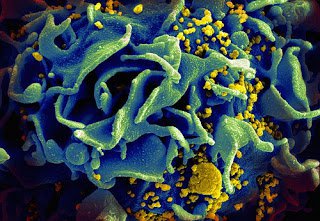The Science: An HIV Cure
by Briana Morgan
by Briana Morgan
April 18, 2013
This post is part of a monthly series published on the third Thursday of every month. In this series, our staff tackle the latest topics and studies related to HIV.

HIV-infected T cell (image from NIAID_Flickr)
Earlier this month, I attended a webinar on the state of HIV cure research. Dr. Steven Deeks did a great job presenting in this AIDS Vaccine Advocacy Coalition (AVAC) webinar. (If you'd like to download his slides or listen to the audio, you can do that here.) Here's a brief overview of the latest in HIV cure research.
Why do we want a cure?
Antiretroviral therapy (ART) doesn't restore health. There are lots of side effects to ART. There are also medication access issues, and adherence can be difficult.
Why doesn't ART cure HIV?
HIV is great at hiding in the body. Even when ART is attacking HIV, there are so-called "viral reservoirs" lying in wait. When treatment is stopped, the hidden HIV springs into action. It's almost like a game of cat and mouse. The trick is finding a way to get rid of the hidden virus.
Functional Cure vs. Sterilizing Cure
When we talk about an "HIV cure," it can be one of two kinds: a functional cure, or a sterilizing cure. A functional cure can be defined as "long-term health in absence of therapy." There might be some virus left in the body, but it's not causing any damage. On the other hand, a sterilizing cure refers to the total eradication of any virus capable of replicating. This refers to complete annhiliation of any HIV in the body.

Timothy Ray Brown in POZ
The Berlin Patient
Timothy Ray Brown, otherwise known as the "Berlin patient," is the first case of a person cured of HIV. Doctors are currently trying to prove that he experienced a sterilizing cure after chemotherapy and a dangerous experimental blood stem cell transplant. The stem cell donor had a CCR5 mutation, which meant that the donor's cells did not have a special receptor that HIV-1 needs in order to take hold. Brown has been off ART for about five years, and there is no evidence of the virus rebounding. In fact, his antibody levels have been declining. Read more about his story here, or get the original study published in the New England Journal of Medicine here.
Baby Cured of HIV in Mississippi
Last month, a new possible cure was announced. In this case, an HIV-positive mother who was not in care gave birth to a baby girl. A pediatrician realized that there would be a high risk of transmission, so they started ART in the baby about 30 hours after delivery. Two blood tests in the baby showed HIV RNA and DNA, so doctors are generally confident that the baby was actually HIV-positive. The child is now 2 1/2 years old and has been off ART for a year. Her immune system is healthy and tests are not easily detecting HIV RNA and DNA. There is debate about what happened - some believe that the virus was only in the mother's cells, others think that only short-lived T cells were infected, and others think that there was something about the baby's immune system that helped eliminate the virus. There's no published study, but you can read an article about the case here.
14 Adults Able to Control HIV Infection in France
Right on the heels of the news of the toddler in Mississippi, French researchers announced that another 14 adults may have been functionally cured of HIV. These individuals were all treated shortly after infection, and were on ART for some time. They then stopped ART, but are able to control the virus without medication. There do not seem to be any characteristics in these adults that could contribute to their ability to control the HIV, aside from their early treatment. Read a New York Times article about the study here, or view the full text of the study from PLOS Pathogens here.
2 More Possibly Cured in Boston
Two more adults may be functionally cured of HIV following bone marrow transplants, much like Timothy Ray Brown was. However, in this case, the donor cells did not have the same CCR5 mutation - so, they were not naturally resistant to HIV-1 like Brown's donor cells. These patients are still on ART, but doctors are unable to find evidence of HIV in their bodies, and their antibody levels are dropping. They're not off ART yet, but their cases look promising. Read an article on the Boston patients here.
Further reading:
Towards an HIV Cure: People Focused, Science Driven
These are the full recommendations from the International AIDS Society Scientific Working Group on HIV Care, presented in July 2012.
For the Win: Find a Cure Faster
Read the AIDS Policy Project's recommendations for improving the overall research system to encourage scientific advancements in finding a cure.
Is there another topic you'd like to see discussed here? Please send any suggestions to info@hivphilly.org, or leave a comment below.
This website is supported by the Health Resources and Services Administration (HRSA) of the U.S. Department of Health and Human Services (HHS) as part of an award totaling $20,808,001. The contents are those of the author(s) and do not necessarily represent the official views of, nor an endorsement, by HRSA, HHS, or the U.S. Government. For more information, please visit HRSA.gov.